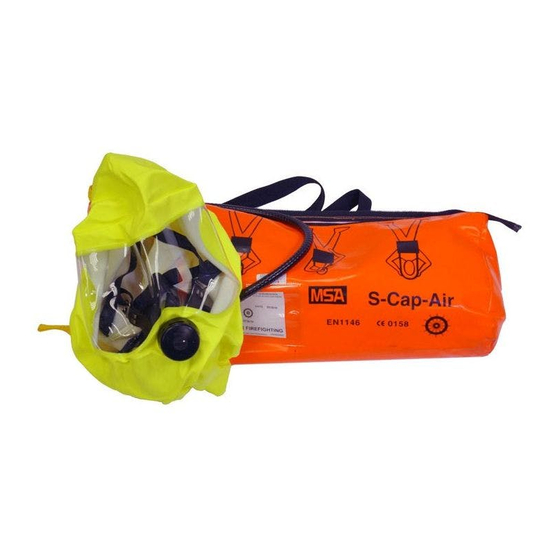Summary of Contents for MSA S-Cap-Air
- Page 1 Operating Manual S-Cap-Air Compressed Air Escape Apparatus with Hood Order N°. 10018537/10...
- Page 2 Schlüsselstr. 12 8645 Rapperswil-Jona Switzerland © MSA All rights reserved...
-
Page 3: Table Of Contents
Visual Check for Damage / Level of the Compressed Air Cylinder... 14 6.4. Regular Checking ..................14 6.5. Annual Check ................... 15 Transport Regulations ..................16 Storage / Stowage ..................... 16 Technical Data ....................17 Ordering Information ..................18 S-Cap-Air... -
Page 4: Safety Regulations
Safety Regulations 1.1. Correct Use The S-Cap-Air is an apparatus for escape from areas with a toxic atmosphere. It protects the wearer during escape from a dangerous ambient atmosphere, with poisonous gases, damaging particles and from lack of oxygen. The S-Cap-Air is only to be used for emergency escape situations and self- rescue. -
Page 5: Description
Thumb loop (yellow) 12 Warning indicator in the hood The S-Cap-Air consists of a hood which is connected to a compressed air cylinder via a medium pressure line. It is stored ready for operation in its carry bag and is started automatically when the bag is opened. -
Page 6: Function
2.2. Function The S-Cap-Air provides the wearer with breathable air in the event of an emergency, for a maximum period of 15 minutes, allowing escape from dangerous areas. The unit provides a constant stream of breathable air in to the hood. -
Page 7: Use
The S-Cap-Air is suitable for adults in good physical and psychological condition. If the S-Cap-Air weigh more than 5 kg (i.e. when using a 3L 200 bar steel cylinder), then the unit should not be carried continuously through the working shift to comply with EN 1146. -
Page 8: Donning The Respiratory Protection Device
Donning the Respiratory Protection Device The unit can be donned using a few simple hand movements in about 20 seconds as follows: Hanging the S-Cap-Air around the neck (1) Hang the carry bag around the neck by the black neck strap. - Page 9 Afterwards put the unit into the carry bag (à Section 5), seal the carry bag with leads and check the bag (à Section 6). If a unit has been made ready but not used, it must at least be checked visually for damage. S-Cap-Air...
-
Page 10: Filling The Compressed Air Cylinder
It has to be reinserted into the valve cap to close the valve before the cylinder can be refilled. If the S-Cap-Air has not been used, the start-up pin will still be in the cylinder valve, with the unzipping loop connected and the valve will be closed. The pin should be aligned parallel to the breathing tube connection. - Page 11 (6) After filling, bleed down the filling connection and release when pressure free (if necessary remove the adaptor). (7) Check the fill level, the cylinder indicator should read 200 bar. (8) Close off the filling connection using the protective cap. (9) Pack the apparatus away (à Section 5). S-Cap-Air...
-
Page 12: Packing The Apparatus
PACKING THE APPARATUS Packing the Apparatus After filling the compressed air cylinder, the S-Cap-Air is packed away in the carry bag as follows: (1) Insert the end of the cylinder carefully into the large black internal loop in the bag, holding the hood connected by the breathing tube carefully whilst doing so. -
Page 13: Maintenance And Service
Always use original MSA parts. Repairs and maintenance must be carried out only by authorised service centres or by MSA. Modifications to complete devices or components are not permitted and automatically result in loss of approved status. -
Page 14: Visual Check For Damage / Level Of The Compressed Air Cylinder
(4) Monthly check of the access to the unit. The access to the unit should not be altered or blocked. Attention! Units which fail the check or which are due for their annual check must be returned for service. S-Cap-Air... -
Page 15: Annual Check
(3) Mark the date of the next yearly check on the unit. After successful checking, the unit should be filled and repacked in accordance with these instructions. Attention! In the event of damage or functional faults, the unit must be returned for service and repair. S-Cap-Air... -
Page 16: Transport Regulations
Packing the S-Cap-Air for transport should be with regard to all applicable national regulations. After transport the S-Cap-Air should, in all cases, be checked for readiness for service. In order to do this, a visual check should be performed in accordance... -
Page 17: Technical Data
§ COMPOSITE-cylinder: 15 years (see Label) Check intervals in accordance with national regulations. Breathing air § In accordance with EN 12021 or USCGA grade D Temperature of the § Corresponding to the storage temperature inhalation air Air supply time 15 minutes S-Cap-Air... -
Page 18: 10. Ordering Information
Bag for S-Cap-Air (replacement) 10018520 Hood for S-Cap-Air (replacement) 10019481 Clips (Hose - pack of 5) 10019483 Filter, felt discs S-Cap-Air (pack of 10) 10019508 Valve cap and start-up pin 10019484 O-ring for connection piece (pack of 10) 10024118 Seal kit (pack of 25) - Page 19 APPENDIX: TEMPLATE Appendix: Template 60° template for cutting out for closing the valve after filling the compressed air cylinder (à Section 4 Point 5) ----- S-Cap-Air...
- Page 20 For local MSA contacts, please visit us at MSAsafety.com Because every life has a purpose...
















Need help?
Do you have a question about the S-Cap-Air and is the answer not in the manual?
Questions and answers